|
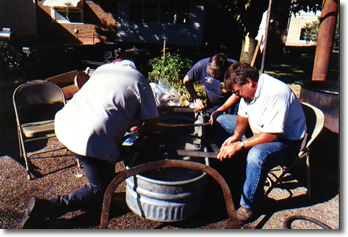
Cleaning stirrers -- Roger Witte, Bill Privia and Bill Stock scrub each stirring paddle to a shiny clean.
|
In the alleyway behind the old town hall, a long row of kettles stands under a makeshift shelter. Each kettle rests in its own housing, under which a bed of sand has been prepared for the firebox where the kindling will be placed later. The kettles have been cleaned, and a crew of men is hard at work scrubbing the parts for the stirring mechanism which goes into each one. |
Most of the kettles used at the Arenzville Burgoo are owned by the village, but a couple of kettles are borrowed each year from private individuals. They are old kettles which have seen a lot of use. "Most of them probably came from people who at one time did their own butchering," says Bill Privia, co-chair of the Kettle and Automatic Stirrers Preparation Committee.
"They've been around a few years, and they're just as brittle as glass. If you drop one, you'll probably get a good crack in it." He says some have been mended with a welding torch, and the town is always on the lookout for suitable replacements. "It's not like you can just go to the Burgoo Catalog and order a new one," says Bill. "Once in a while, we will see one on an estate auction, and we might go see what kind of condition it is in."
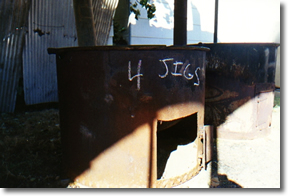
|
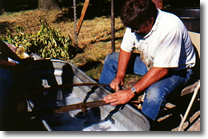
Scrubbing - Bill Stock works on cleaning a stirring paddle.
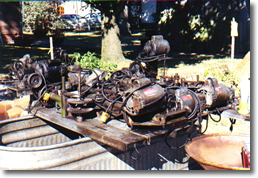
Motors -- recycled from an earlier use in a workshop or washing machine, these motors now drive the paddles in burgoo kettles.
|
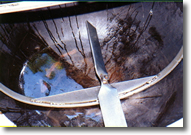 The village owns 12 kettles and borrows three others for use during the annual Burgoo. One of those comes from Jiggs Ginder, who each year lends the kettle to the town. His brother, Clyde, remembers that he was just a small child when their father, John Ginder, bought the kettle at an auction. "It must have been about 1926," says Clyde. "I remember when he got it." The village owns 12 kettles and borrows three others for use during the annual Burgoo. One of those comes from Jiggs Ginder, who each year lends the kettle to the town. His brother, Clyde, remembers that he was just a small child when their father, John Ginder, bought the kettle at an auction. "It must have been about 1926," says Clyde. "I remember when he got it."
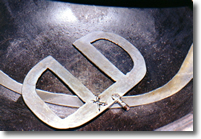 The automatic stirrers are evidence of the ingenuity of earlier burgoomeisters. The boiling soup requires constant stirring during the 14 hours of cooking time, and until just a couple decades ago, the job was done with long-handled wooden paddles that the men kept moving all night long. If they neglected to scrape the sides and bottom of the kettle, the soup would scorch and the burgoo was ruined. It was a hot and tiresome job which required attention through the night. And if the wind was blowing in the wrong direction, the job was made even more miserable by inescapable smoke. The automatic stirrers are evidence of the ingenuity of earlier burgoomeisters. The boiling soup requires constant stirring during the 14 hours of cooking time, and until just a couple decades ago, the job was done with long-handled wooden paddles that the men kept moving all night long. If they neglected to scrape the sides and bottom of the kettle, the soup would scorch and the burgoo was ruined. It was a hot and tiresome job which required attention through the night. And if the wind was blowing in the wrong direction, the job was made even more miserable by inescapable smoke.
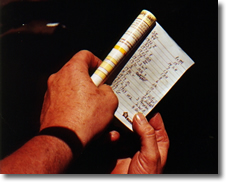 In the early 1960's, some inventive fellows (most people credit Herb and Ed Tegeder) devised a motorized stirring mechanism with a two-piece paddle driven by an old washing machine motor. The motor was mounted on a steel beam secured across the rim of the kettle, and the lower stirring paddle was custom-made to fit the bottom of each kettle. (Click here for larger images of the custom-made stirrers.) In the early 1960's, some inventive fellows (most people credit Herb and Ed Tegeder) devised a motorized stirring mechanism with a two-piece paddle driven by an old washing machine motor. The motor was mounted on a steel beam secured across the rim of the kettle, and the lower stirring paddle was custom-made to fit the bottom of each kettle. (Click here for larger images of the custom-made stirrers.)
Most stirrers use a D-shaped paddle to scrape the bottom of the kettle, but the design of the second paddle stirring the middle level of the soup varies, depending on the ingenuity of the builder. To further complicate matters, the bottom of each kettle has a distinctive shape, which requires that only the stirrer designed for that kettle be used. Each year, the kettle preparation crew must carefully match the stirrers and kettles. The parts are marked with scrawled numbers engraved on the metal, but don't expect any logic to this system. "Stirrer number 5 goes with kettle number 10," says Bill as he consults his master list. "If we get the wrong stirring machine on the wrong kettle, then it's potential disaster."
Some old-timers were reluctant to switch from the old wooden paddles to the motor-driven version. "Aw, you'll ruin the soup," they said. But it required two dozen men to stir the soup by hand all night long, and if they worked in two shifts, then even more were needed. When the electric motor stirrers proved effective, a similar contraption was made for each kettle. "They weren't all made the same year," says Bill. But over a period of about ten years a complete transition was made. The wooden paddles are still necessary for certain stages of the cooking, as I learned later.
Continued...
|
 ARENZVILLE, IL | HOME OF THE WORLD'S BEST BURGOO
ARENZVILLE, IL | HOME OF THE WORLD'S BEST BURGOO 



 The village owns 12 kettles and borrows three others for use during the annual Burgoo. One of those comes from Jiggs Ginder, who each year lends the kettle to the town. His brother, Clyde, remembers that he was just a small child when their father, John Ginder, bought the kettle at an auction. "It must have been about 1926," says Clyde. "I remember when he got it."
The village owns 12 kettles and borrows three others for use during the annual Burgoo. One of those comes from Jiggs Ginder, who each year lends the kettle to the town. His brother, Clyde, remembers that he was just a small child when their father, John Ginder, bought the kettle at an auction. "It must have been about 1926," says Clyde. "I remember when he got it." The automatic stirrers are evidence of the ingenuity of earlier burgoomeisters. The boiling soup requires constant stirring during the 14 hours of cooking time, and until just a couple decades ago, the job was done with long-handled wooden paddles that the men kept moving all night long. If they neglected to scrape the sides and bottom of the kettle, the soup would scorch and the burgoo was ruined. It was a hot and tiresome job which required attention through the night. And if the wind was blowing in the wrong direction, the job was made even more miserable by inescapable smoke.
The automatic stirrers are evidence of the ingenuity of earlier burgoomeisters. The boiling soup requires constant stirring during the 14 hours of cooking time, and until just a couple decades ago, the job was done with long-handled wooden paddles that the men kept moving all night long. If they neglected to scrape the sides and bottom of the kettle, the soup would scorch and the burgoo was ruined. It was a hot and tiresome job which required attention through the night. And if the wind was blowing in the wrong direction, the job was made even more miserable by inescapable smoke. In the early 1960's, some inventive fellows (most people credit Herb and Ed Tegeder) devised a motorized stirring mechanism with a two-piece paddle driven by an old washing machine motor. The motor was mounted on a steel beam secured across the rim of the kettle, and the lower stirring paddle was custom-made to fit the bottom of each kettle. (
In the early 1960's, some inventive fellows (most people credit Herb and Ed Tegeder) devised a motorized stirring mechanism with a two-piece paddle driven by an old washing machine motor. The motor was mounted on a steel beam secured across the rim of the kettle, and the lower stirring paddle was custom-made to fit the bottom of each kettle. (